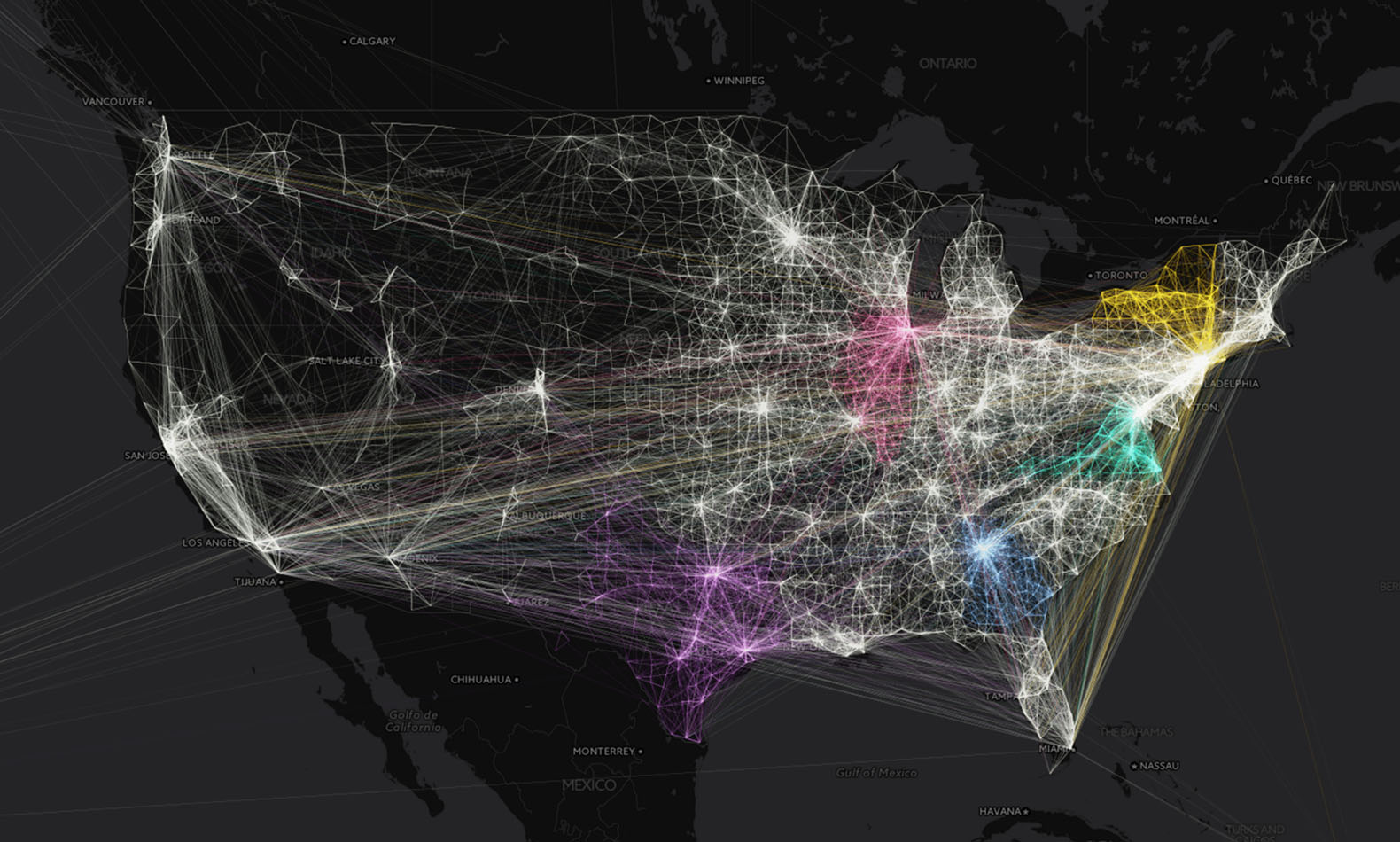
Spatial interaction is a fascinating concept that explores the way people, goods, and ideas move and interact within geographical spaces. It plays a crucial role in shaping our world, from influencing urban planning to determining transportation routes and economic patterns. While many aspects of spatial interaction may seem familiar, there are also numerous surprising and lesser-known facts that shed light on the intricacies of this phenomenon. In this article, we will uncover 20 surprising facts about spatial interaction that will not only ignite your curiosity but also deepen your understanding of how humans and their environment are interconnected. Get ready to embark on a journey of discovery as we delve into the intriguing world of spatial interaction.
Key Takeaways:
- Spatial interaction is the flow of people, goods, and ideas between places, shaping our world and influencing everything from trade to cultural diversity.
- Understanding spatial interaction helps us plan cities, predict disease spread, and even tackle social inequalities, and it will keep evolving with technology and globalization.
Spatial interaction is the flow of goods, people, information, and ideas between different locations.
Spatial interaction plays a crucial role in shaping the interconnectedness and dynamics of our world. It enables the exchange of resources, facilitates cultural diffusion, and influences the development of societies.
The concept of spatial interaction can be traced back to the early 20th century.
Geographers and transportation planners began studying spatial interaction to understand patterns of movement and connectivity. The field has since evolved, incorporating advances in technology and communication.
Gravity models are commonly used to analyze and predict spatial interaction.
Gravity models apply the principle of gravitation to spatial relationships. They consider factors like distance, population, and economic activity to estimate the likelihood and intensity of interactions between locations.
Spatial interaction is not limited to physical movement.
While transportation is a prominent form of spatial interaction, it also encompasses virtual interactions through telecommunications and the internet. This digital connectivity has revolutionized global communication and transformed the way we interact.
Spatial interaction has influenced urban planning and development.
Understanding spatial interaction patterns helps city planners optimize transportation networks, locate amenities strategically, and improve accessibility for residents. It contributes to efficient land use and sustainable urban development.
The concept of spatial interaction is relevant in fields beyond geography.
Economists, sociologists, and political scientists also study spatial interaction to examine market dynamics, social networks, and political relationships. It provides insights into the interconnected nature of various phenomena.
The flow of goods in spatial interaction impacts global trade and economic systems.
The movement of commodities, raw materials, and finished products between countries drives international trade. Spatial interaction patterns influence the distribution of industries and the competitiveness of nations.
Spatial interaction affects migration patterns and population distribution.
People’s decisions to relocate are often influenced by factors like job opportunities, quality of life, and cultural attractions. Spatial interaction analysis helps understand these migration patterns and their impact on population distribution.
Spatial interaction can contribute to the spread of diseases.
The movement of people, particularly in densely populated areas, can accelerate the transmission of infectious diseases. Understanding spatial interaction patterns is crucial for modeling and managing disease outbreaks.
The development of transportation infrastructure has significantly influenced spatial interaction.
The construction of roads, railways, airports, and ports has facilitated the movement of goods and people across long distances. It has connected regions, transformed economies, and fostered cultural exchange.
Spatial interaction can be influenced by cultural and social factors.
Cultural similarities, shared languages, and historical ties can enhance spatial interaction between certain regions. On the other hand, political tensions or language barriers can impede interactions.
Spatial interaction is not always symmetrical.
Interactions between locations can vary in terms of intensity and direction. Some regions may have higher levels of interaction with specific locations due to economic, historical, or geographical factors.
Advances in technology have revolutionized spatial interaction.
The rise of internet connectivity, mobile devices, and online platforms has made spatial interaction faster, easier, and more accessible. It has transformed how we communicate, shop, and connect with others globally.
Spatial interaction can shape cultural diffusion.
As people, goods, and ideas move between locations, cultural traits and practices can spread and influence local cultures. The process of cultural diffusion contributes to the diversity and evolution of societies.
Spatial interaction is influenced by economic factors such as supply and demand.
The availability of resources, market demand, and economic incentives can drive spatial interactions. Understanding these economic factors is essential for businesses and policymakers in making informed decisions.
New modes of transportation, such as drones and hyperloop systems, have the potential to revolutionize spatial interaction.
Technological advancements are constantly reshaping the way we move goods and people. Innovations like drones for delivery and hyperloop systems for high-speed transportation could transform spatial interaction in the future.
Spatial interaction can be impacted by natural disasters and climate change.
Events like hurricanes, earthquakes, or rising sea levels can disrupt transportation networks and impede spatial interaction. Understanding these risks is essential for disaster preparedness and resilience planning.
Spatial interaction can have environmental implications.
The movement of goods and people can contribute to pollution, carbon emissions, and habitat destruction. Sustainable spatial planning aims to minimize these environmental impacts and promote eco-friendly transportation solutions.
The study of spatial interaction provides insights into regional disparities and social inequalities.
Examining the patterns of spatial interaction can reveal disparities in access to resources, opportunities, and services. It helps identify areas where interventions and policies are needed to promote equitable development.
Spatial interaction will continue to evolve with ongoing advancements in technology and globalization.
As technology continues to transform the way we connect and interact, spatial interaction will adapt and expand. It will shape the future of transportation, communication, and global connectivity.
Conclusion
In conclusion, spatial interaction is a fascinating concept that plays a crucial role in shaping our world. From the movement of people and goods to the exchange of information and ideas, spatial interaction affects every aspect of our daily lives. The 20 surprising facts outlined in this article shed light on the complexity and interconnectedness of spatial interaction. From the impact of transportation systems to the influence of cultural factors, there are countless factors at play in shaping how and why spatial interaction occurs. By understanding these facts and studying the patterns and trends of spatial interaction, we can gain valuable insights into the dynamics of human behavior and make informed decisions to improve the efficiency and sustainability of our global society.
FAQs
1. What is spatial interaction?
Spatial interaction refers to the flow or movement of people, goods, information, and ideas between different locations. It involves the connection and exchange between places and plays a vital role in shaping economic, social, and cultural patterns.
2. What factors influence spatial interaction?
Several factors influence spatial interaction, including distance, transportation infrastructure, cultural barriers, economic conditions, and government policies. These factors can either facilitate or constrain the movement and exchange between different locations.
3. How does transportation affect spatial interaction?
Transportation systems, such as roads, railways, air travel, and shipping routes, play a significant role in facilitating spatial interaction. Efficient and well-connected transportation networks can enhance accessibility and reduce travel time, thereby promoting the movement of people, goods, and information.
4. Can spatial interaction be influenced by cultural factors?
Yes, cultural factors, such as language, customs, and social norms, can influence spatial interaction. Cultural similarities or differences between regions can affect the flow of people, ideas, and goods, as well as shape the preferences and behavior of individuals in terms of spatial interactions.
5. Why is studying spatial interaction important?
Studying spatial interaction is important as it helps us understand the patterns, dynamics, and implications of human behavior and movement between places. It provides insights into urban planning, transportation management, market analysis, and policy-making, leading to more efficient and sustainable development.
Was this page helpful?
Our commitment to delivering trustworthy and engaging content is at the heart of what we do. Each fact on our site is contributed by real users like you, bringing a wealth of diverse insights and information. To ensure the highest standards of accuracy and reliability, our dedicated editors meticulously review each submission. This process guarantees that the facts we share are not only fascinating but also credible. Trust in our commitment to quality and authenticity as you explore and learn with us.


